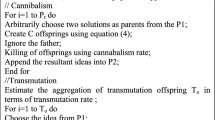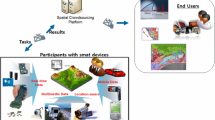Abstract
Crowdsourcing is a procedure of outsourcing the data to an abundant range of individual workers rather than considering an exclusive entity or a company. It has made various types of chances for some difficult issues by utilizing human knowledge. To acquire a worldwide optimal task assignment scheme, the platform usually needs to collect location information of all workers. During this procedure, there is a major security concern; i.e., the platform may not be trustworthy, and so, it brings about a threat to workers location privacy. Recently, many distinguished research papers are published to address the security and privacy issues in mobile crowdsourcing. According to our knowledge, the security issues that occur in terms of data reporting were not addressed. Secure and efficient data aggregation and data reporting are the critical issue in Mobile Crowdsourcing (MCS). Cluster-based mobile crowdsourcing (CMCS) is the efficient way for data aggregation and data reporting. In this paper, we propose a novel procedure, the efficient fuzzy logic cluster formation protocol (EFLCFP) for cluster formation, and use cluster cranium (CC) for data aggregation and data reporting. We recommend a couple of secure and efficient data transmission (SET) protocols for CMCS, (i) SET-IBE uses additively homomorphic identity-based encryption system and (ii) SET-IBOOS uses the identity-based online/offline digital signature system, respectively. Then, we have widen the features of cluster cranium by increasing the propensity to achieve aggregation and reporting on the data yielded by the requesters without scarifying their privacy. Also, considering query optimization using cost and latency.
Access this chapter
Tax calculation will be finalised at checkout
Purchases are for personal use only
Similar content being viewed by others
References
Howe J (2006) The rise of crowdsourcing. Wired Mag 53(10):1–4
Fuchs-Kittowski F, Faust D (2014) Architecture of mobile crowdsourcing systems. In: Baloian N, Burstein F, Ogata H, Santoro F, Zurita G (eds) Collaboration and technology. Lecture notes in computer science. Springer, Cham, pp 121–136
Abououf M, Singh S, Otrok H, Mizouni R, Ouali A (2018) Galeshapley matching game selection—a framework for user satisfaction. IEEE Access 7:3694–3703
Fan J, Zhang M, Kok S, Lu M, Ooi BC (2015) Crowdop: query optimization for declarative crowdsourcing systems. IEEE Trans Knowl Data Eng 27(8):2078–2092
Parameswaran A, Park H, Garcia-Molina H, Poluzotis N, Widom J (2012) Deco: declarative crowdsourcing. In: CIKM. ACM, pp 1203–1212
Yuen M-C, King I, Leung KS (2012) Task recommendation in crowdsourcing systems. In: CrowdKDD’12, Beijing, 12 Aug 2012
Franklin MJ, Kossmann D, Kraska T, Ramesh S (2011) Crowd DB: answering queries with crowdsourcing. In: SIGMOD, pp 61–72
Hu S, Su L, Liu H, Wang H, Abdelzaher TF (2015) SmartRoad: smartphone-based crowd sensing for traffic regulator detection and identification. ACM Trans Sens Netw 11(4):1–27. https://doi.org/10.1145/2770876
Kantarci B, Mouftah HT (2014) Trustworthy sensing for public safety in cloud-centric Internet of Things. IEEE Internet Things J 1(4):360–368. https://doi.org/10.1109/JIOT.2014.2337886
Ran G, Zhang H (2010) Improving on LEACH protocol of wireless sensor networks using fuzzy logic. J Inf Comput Sci 7(3):767–775
Gupta I (2005) Cluster head election using fuzzy logic for wireless sensor networks. Halifax, Nova Scotia, Mar 2005
Feng W, Yan Z (2018) A survey on security, privacy, and trust in mobile crowdsourcing. IEEE Internet Things J 5(4)
Basu A, Vaidya J, Corena JC, Kiyomoto S, Marsh S, Guo G, Zhang J, Miyake Y (2014) Opinions of people: factoring in privacy and trust. SIGAPP Appl Comput Rev 14(3):7–21
Blasco S, Bustos-Jimenez J, Font G, Hevia A, Prato MG (2015) A three-layer approach for protecting smart-citizens privacy in crowdsensing projects. In: Proceedings of international conference of the Chilean computer science society (SCCC), Santiago, pp 1–5. https://doi.org/10.1109/SCCC.2015.7416585
Günther F, Manulis M, Peter A (2014) Privacy-enhanced participatory sensing with collusion resistance and data aggregation. In: Proceedings of international conference on cryptology and network security (CANS), Heraklion, pp 321–336. https://doi.org/10.1007/978-3-319-12280-9_21
Wu H-Q, Wang L, Xue G (2019) Privacy-aware task allocation and data aggregation in fog-assisted spatial crowdsourcing. IEEE Trans Netw Sci Eng. https://doi.org/10.1109/TNSE.2019.2892583
Paillier P (1999) Public-key cryptosystems based on composite degree residuosity classes. In: Eurocrypt
Fan J, Li Q, Cao G (2015) Privacy-aware and trustworthy data aggregation in mobile sensing. In: 2015 IEEE conference on communications and network security (CNS), Florence, pp 31–39. https://doi.org/10.1109/CNS.2015.7346807
Bhaskar N, Mohan Kumar P (2020) Optimal processing of nearest-neighbor user queries in crowd sourcing based on the whale optimization algorithm. Soft Comput. https://doi.org/10.1007/s00500-020-04722-0
Bhaskar N, Mohan Kumar P, Arokia Renjit J (2020) Evolutionary fuzzy-based gravitational search algorithm for query optimization in crowdsourcing system to minimize cost and latency. Comput Intell. https://doi.org/10.1111/coin.12382
Safran M, Che D (2016) Real-time recommendation algorithms for crowdsourcing systems. Appl Comput Inform. https://doi.org/10.1016/j.aci.2016.01.001
Kim J, Park S, Han Y, Chung T (2008) CHEF: cluster head election mechanism using fuzzy logic in wireless sensor networks. In: 10th international conference on advanced communication technology, ICACT 2008, pp 654–659
Gheisari M, Abbasi AA, Sayari Z, Rizvi Q, Asheralieva A, Banu S, Awaysheh FM, Shah SBH, Raza KA (2020) A survey on clustering algorithms in wireless sensor networks: challenges, research, and trends. In: International computer symposium (ICS). https://doi.org/10.1109/ICS51289.2020.00065
Zhang J, Sheng VS, Wu J (2019) Crowdsourced label aggregation using bilayer collaborative clustering. IEEE Trans Neural Netw Learn Syst 30(10)
Adil M, Khan R, Ali J, Roh B-H, Ta QTH, Almaiah MA (2020) An energy proficient load balancing routing scheme for wireless sensor networks to maximize their lifespan in an operational environment. IEEE Access 8
Wu C-C, Chen K-T, Chang Y-C, Lei C-L (2013) Crowdsourcing multimedia QoE evaluation: a trusted framework. IEEE Trans Multimedia 15(5):1121–1137. https://doi.org/10.1109/TMM.2013.2241043
Baveye Y, Dellandréa E, Chamaret C, Chen L (2015) LIRISACCEDE: a video database for affective content analysis. IEEE Trans Affect Comput 6(1):43–55. https://doi.org/10.1109/TAFFC.2015.2396531
Joe CV, Raj JS (2021) Location-based orientation context dependent recommender system for users. J Trends Comput Sci Smart Technol (TCSST) 3(01):14–23
Mhemed R, Aslam N, Phillips W, Comeau F (2012) An energy efficient fuzzy logic cluster formation protocol in wireless sensor networks. In: The 3rd international conference on ambient systems, networks and technologies (ANT), 1877-0509 © 2012. Published by Elsevier Ltd. https://doi.org/10.1016/j.procs.2012.06.035
Heinzelman W, Chandrakasan A, Balakrishnan H (2002) An application-specific protocol architecture for wireless microsensor networks. IEEE Trans Wireless Commun 1(4):660–670
Mamdani EH (1977) Application of fuzzy logic to approximate reasoning using linguistic synthesis. IEEE Trans Comput C-26:1182–1191
Pithva B, Pattani K, Christian A (2014) Optimization of leach protocol in wireless sensor network. Int J Comput Appl 93(12)
Oliveira LB, Ferreira A, Vilaca MA et al (2007) SecLEACH—on the security of clustered sensor networks. Signal Process 87
Banerjee P, Jacobson D, Lahiri S (2007) Security and performance analysis of a secure clustering protocol for sensor networks. In: Proceedings of IEEE NCA
Zhang K, Wang C, Wang C (2008) A secure routing protocol for cluster-based wireless sensor networks using group key management. In: Proceedings of WiCOM
Lu H, Li J, Guizani M (2014) Secure and efficient data transmission for cluster-based wireless sensor networks. IEEE Trans Parallel Distrib Syst 25(3)
Galindo D (2005) Boneh-Franklin identity based encryption revisited. In: Caires L, Italiano GF, Monteiro L, Palamidessi C, Yung M (eds) Automata, languages and programming. ICALP 2005. Lecture notes in computer science, vol 3580. Springer, Berlin, Heidelberg. https://doi.org/10.1007/11523468_64
Castelluccia C, Mykletun E, Tsudik G (2005) Efficient Aggregation of encrypted data in Wireless Sensor Networks. The Second Annual International Conference on Mobile and Ubiquitous Systems: Networking and Services. http://doi.org/10.1109/MOBIQUITOUS.2005.25
Renukadevi M, Mary Anita EA, Mohanageetha D (2021) An efficient privacy-preserving model based on OMFTSA for query optimization in crowdsourcing. Concurr Comput Pract Exp. https://doi.org/10.1002/cpe.6447
Azad P, Sharma V (2013) Cluster head selection in wireless sensor networks under fuzzy environment. ISRN Sens Netw 2013. https://doi.org/10.1155/2013/909086
Author information
Authors and Affiliations
Editor information
Editors and Affiliations
Rights and permissions
Copyright information
© 2022 The Author(s), under exclusive license to Springer Nature Singapore Pte Ltd.
About this paper
Cite this paper
Renukadevi, M., Mary Anita, E.A., Mohana Geetha, D. (2022). An Efficient Fuzzy Logic Cluster Formation Protocol for Data Aggregation and Data Reporting in Cluster-Based Mobile Crowdsourcing. In: Shakya, S., Du, KL., Haoxiang, W. (eds) Proceedings of Second International Conference on Sustainable Expert Systems . Lecture Notes in Networks and Systems, vol 351. Springer, Singapore. https://doi.org/10.1007/978-981-16-7657-4_35
Download citation
DOI: https://doi.org/10.1007/978-981-16-7657-4_35
Published:
Publisher Name: Springer, Singapore
Print ISBN: 978-981-16-7656-7
Online ISBN: 978-981-16-7657-4
eBook Packages: Intelligent Technologies and RoboticsIntelligent Technologies and Robotics (R0)




